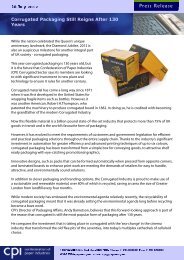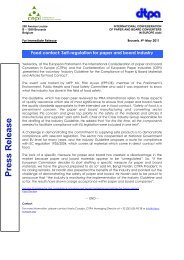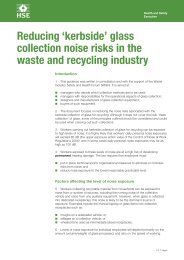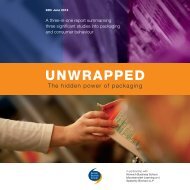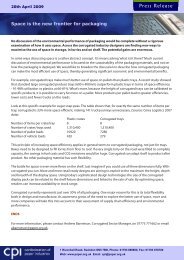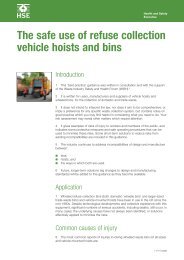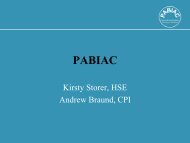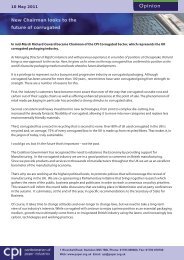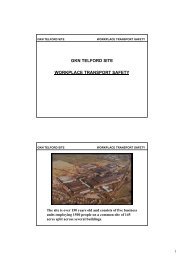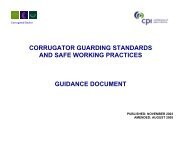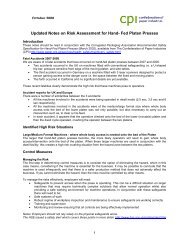Industry guideline for the Compliance of Paper & Board ... - cepi
Industry guideline for the Compliance of Paper & Board ... - cepi
Industry guideline for the Compliance of Paper & Board ... - cepi
Create successful ePaper yourself
Turn your PDF publications into a flip-book with our unique Google optimized e-Paper software.
1<br />
1.1 Objective<br />
Introduction<br />
This document is aimed at manufacturers <strong>of</strong> paper and board materials and articles intended <strong>for</strong><br />
food contact and is designed to provide guidance <strong>for</strong> establishing compliance with Regulation<br />
(EC) No 1935/2004. Whilst it provides a methodology <strong>for</strong> <strong>the</strong> demonstration <strong>of</strong> <strong>the</strong> suitability <strong>of</strong><br />
materials and articles <strong>for</strong> a variety <strong>of</strong> food contact applications, in itself it has no legal <strong>for</strong>ce. Its<br />
use is voluntary and it should be noted that o<strong>the</strong>r compliance mechanisms exist which may be<br />
used separately or in conjunction with this Guideline.<br />
It is <strong>the</strong> intention that <strong>the</strong> contents <strong>of</strong> this document are not fixed and will be updated in<br />
accordance with evolving best practice and knowledge <strong>of</strong> food safety. See Annex 5 <strong>for</strong> details <strong>of</strong><br />
developments currently in progress within <strong>the</strong> paper and board industry.<br />
4<br />
1.2 Field <strong>of</strong> Application<br />
<strong>Paper</strong> and board materials and articles are manufactured from cellulose-based natural fibres both<br />
bleached and unbleached, from primary and recycled sources. In addition paper and board may<br />
contain functional additives and syn<strong>the</strong>tic fibres and also o<strong>the</strong>r treatment agents and polymeric<br />
binders <strong>for</strong> organic and inorganic pigments.<br />
This Guideline applies to materials and articles constituted <strong>of</strong> paper and board (excluding nonwovens<br />
as defined by ISO 9092) which may comprise one or more layers <strong>of</strong> fibre and which in<br />
<strong>the</strong>ir finished state:<br />
• are intended to be brought into contact with food, or<br />
• are already in contact with food and were intended <strong>for</strong> that purpose, or<br />
• can reasonably be expected to be brought into contact with food or to transfer <strong>the</strong>ir<br />
constituents to food under normal or <strong>for</strong>eseeable conditions <strong>of</strong> use.<br />
The two principal operations in <strong>the</strong> manufacture <strong>of</strong> paper and board materials and articles <strong>for</strong><br />
food contact are normally papermaking and conversion. Most <strong>of</strong> <strong>the</strong> specific requirements given<br />
in this Guideline will apply at <strong>the</strong> papermaking stage and will be applicable to paper and board at<br />
<strong>the</strong> completion <strong>of</strong> that operation. Some requirements are relevant to <strong>the</strong> converting operation.<br />
<strong>Paper</strong> and board includes mineral coated papers, and <strong>the</strong> components including polymeric<br />
binders in <strong>the</strong> coating <strong>for</strong>mula are covered by <strong>the</strong> requirements <strong>of</strong> this Guideline.<br />
This Guideline may also be applied to paper and board as it is used in o<strong>the</strong>r coated and laminated<br />
materials, including combinations with plastics, aluminium, and waxes. Specific sections <strong>of</strong> this<br />
Guideline deal with multi-material multi-layer materials involving combinations <strong>of</strong> paper and<br />
board and plastics, filtering and baking applications, and packaging not actually in food contact.<br />
Tissue paper, kitchen towels and napkins are covered by specific <strong>guideline</strong>s (Ref. 3) and<br />
are excluded from <strong>the</strong> scope <strong>of</strong> this Guideline.<br />
In providing requirements and a methodology to establish compliance with Regulation<br />
1935/2004, it is expected that this Guideline would become widely used by companies operating<br />
in markets potentially covering all member states <strong>of</strong> <strong>the</strong> European Union. Certain European<br />
countries have specific national legislation covering food contact applications which will take<br />
precedence over this Guideline and compliance with that legislation may be required.



